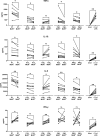Unravelling the mechanisms causing murepavadin resistance in Pseudomonas aeruginosa: lipopolysaccharide alterations and its consequences
- PMID: 39711784
- PMCID: PMC11659217
- DOI: 10.3389/fcimb.2024.1446626
Unravelling the mechanisms causing murepavadin resistance in Pseudomonas aeruginosa: lipopolysaccharide alterations and its consequences
Abstract
Introduction: Murepavadin is an antimicrobial peptide (AMP) in clinical development that selectively targets Pseudomonas aeruginosa LptD and whose resistance profile remains unknown. We aimed to explore genomic modifications and consequences underlying murepavadin and/or colistin susceptibility.
Methods: To define genomic mechanisms underlying resistance, we performed two approaches: 1) a genome-wide association study (GWAS) in a P. aeruginosa clinical collection (n=496), considering >0.25 mg/L as tentative cut-off of murepavadin acquired resistance; 2) a paired genomic comparison in a subset of 5 isolates and their isogenic murepavadin-resistant mutants obtained in vitro. Lipid-A composition, immunogenicity and cathelicidin and indolicidin effects on bacterial growth were also tested in this last subset of isolates. Murepavadin MICs were determined in ΔlpxL1 and ΔlpxL2 knock-out mutants obtained from a auxotroph PAO1 derivative.
Results: GWAS revealed a missense variant (A→G p.Thr260Ala in the hisJ gene) associated with murepavadin resistance although both resistant and susceptible strains harbored it (21% and 12% respectively, OR=1.92, p=0.012 in χ² test). Among the isolate subset, murepavadin-resistant mutants with deletions in lpxL1 and lpxL2 genes showed lower abundance of hexa-acylated lipid-A (m/z 1616, 1632). 4-aminoarabinose addition was found only in colistin-resistant isolates but not in the other ones, irrespective of murepavadin susceptibility. Accordingly, ΔlpxL1 and ΔlpxL2 mutants exhibited higher murepavadin MICs than parental PAO1 auxotroph strain (2 and 4 vs 0.5 mg/L respectively). Lipopolysaccharide from murepavadin-resistant mutants triggered lower inflammatory responses in human monocytes. Those with lpxL mutations and hexa-acylated lipid-A loss also exhibited greater growth reduction when exposed to host-derived AMPs cathelicidin and indolicidin.
Discussion: High murepavadin-resistance seems to be linked to lpxL1 and lpxL2 mutations and lower hexa-acylated lipid-A, corresponding to lower inflammatory induction and higher susceptibility to host-derived AMPs. Although GWAS identified one variant associated with the murepavadin-resistant phenotype, data revealed that there was no unique single genetic event underlying this phenotype. Our study provides insight into the mechanisms underlying murepavadin susceptibility.
Keywords: antibiotic resistance; colistin; host-derived antimicrobial peptides; innate immune system; monocytes; murepavadin.
Copyright © 2024 Hernández-García, Barbero-Herranz, Bastón-Paz, Díez-Aguilar, López-Collazo, Márquez-Garrido, Hernández-Pérez, Baquero, Ekkelenkamp, Fluit, Fuentes-Valverde, Moscoso, Bou, del Campo, Cantón and Avendaño-Ortiz.
Conflict of interest statement
Author FM-G is employee of Bruker Española S.A. The remaining authors declare that the research was conducted in the absence of any commercial or financial relationships that could be construed as a potential conflict of interest.
Figures





References
-
- Avendaño-Ortiz J., Llanos-González E., Toledano V., Del Campo R., Cubillos-Zapata C., Lozano-Rodríguez R., et al. . (2019). Pseudomonas aeruginosa colonization causes PD-L1 overexpression on monocytes, impairing the adaptive immune response in patients with cystic fibrosis. J. Cyst. Fibros. 18, 630–635. doi: 10.1016/j.jcf.2018.11.002 - DOI - PubMed
MeSH terms
Substances
LinkOut - more resources
Full Text Sources
Medical

